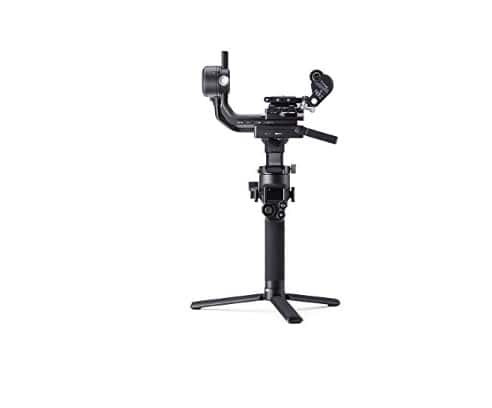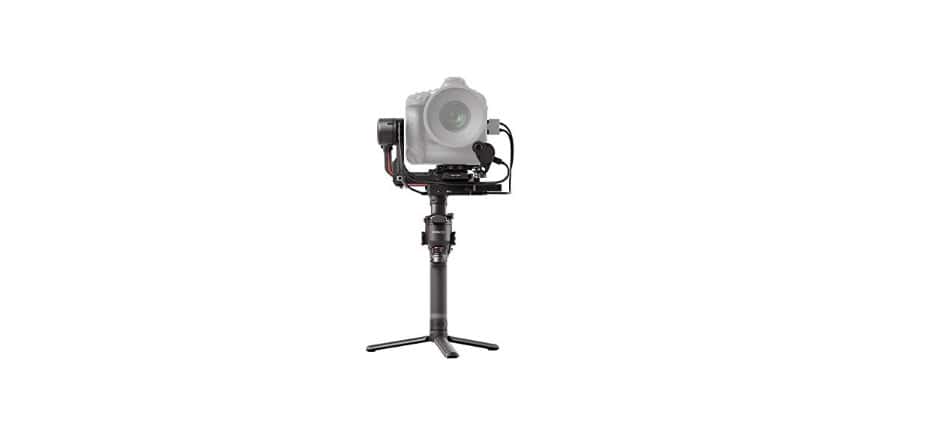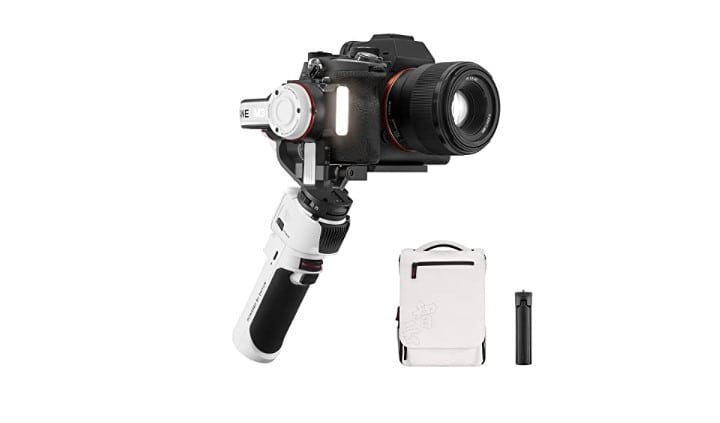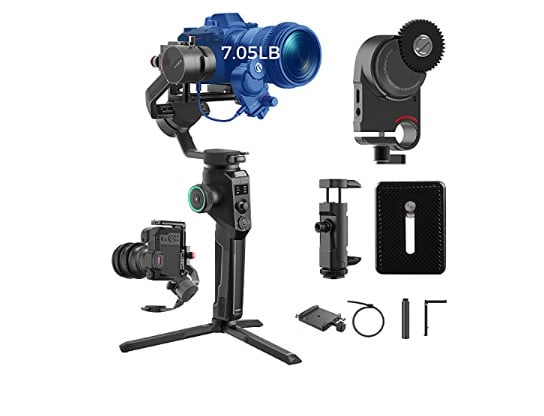
DJI RSC 2 Combo

DJI Ronin-SC

Zhiyun Crane M3 Combination Handheld
Sony’s a6000, one of the most popular mirrorless cameras on the market, produces beautiful results. This Sony camera is the best of all the previous models and price levels. It’s no wonder this camera has grown popular among pros and amateurs.
Many people are confused about what to look for when selecting a fantastic gimbal for the Sony a6000. However, you may be unaware that the a6000 is so light that it can be attached to nearly any Gimbals.
Here is the list of gimbals for the Sony a6000.
Top 4 Best Gimbals for Sony a6000
1. DJI RSC 2 Combo
The DJI RSC 2 Pro Combo offers additional attachments to the RSC 2 gimbal for Sony a6000, allowing for a more comprehensive workflow.
The DJI Ronin RavenEye Image Transmission is a substantial enhancement that allows for 330′ of 1080p video transmission from the Sony a6000 gimbals with a latency of approximately 50ms, allowing for on-set collaboration.
The extras supplied with the Raven Eye are a focus motor, a phone holder, two focus gears, and three HDMI cables. There is also a tote box and a compact metal tripod supplied.
The DJI RSC 2 is designed for mirrorless and DSLR cameras and can carry up to 6.6 pounds of camera gear. For the most up-to-date list of compatible cameras and lenses, please visit the DJI website.
The Ronin-SC’s motors, which improved Gimbal’s predecessor, were only 25% as powerful as those in the RSC 2. The foldable design of the RSC 2, which allows for conversion to underslung mode, is a critical feature.
Specifications
Weight
7.2 pounds (3.3 kilograms)
Dimensions
2.6 x 2.6 x 2.6 inches (66 x 66 x 66 mm)
Stabilization Method
3-axis gimbal with electronic image stabilization
Stabilization Accuracy
+/- 0.02 degrees pitch, roll, and yaw
Operating Temperature Range
32 to 104 Fahrenheit
Features
- Scientific Design for a Relaxing Experience
- Long Battery Life Support
- Flexible Silicone Charge Reversal
- Scientific Design for a Relaxing Experience
Benefits
- Foldable Screen Built-in Design
- Smooth as silk
- Lightweight built-in focus wheel (1.2 kg)
Drawbacks
- Finding the proper balance requires time and effort.
- The battery is not replaceable.
2. DJI Ronin-SC
In addition to the RS 2 gimbals, the DJI RS contains several additional attachments for a more comprehensive workflow.
The DJI Ronin Raven Eye Image Transmission System is a substantial enhancement that allows for 330′ of 1080p video transmission from the Gimbal with a latency of approximately 50ms, allowing for on-set collaboration.
The accessories are a focus motor, a phone holder, two focus gears, and three HDMI cables. The RS 2 is a newer version of the Ronin-S Gimbals with a payload capability of up to 10 lb.
It is roughly 25% lighter and more compact thanks to monocoque carbon fiber axis arms and a shorter grip handle with a smaller battery cartridge, yet still having a 12-hour runtime.
The motors are roughly 20% more powerful and support cameras such as the Black magic Pocket 6K, Canon 1D X Mark III, Sony a7S III, and ALEXA Mini LF. For the most up-to-date list of compatible cameras and lenses, please visit the DJI website.
Specifications
Weight
13.2 ounces (375 grams)
Dimensions
2.3 x 2.3 x 2.3 inches (58 x 58 x 58 mm)
Stabilization Method
3-axis gimbal with electronic image stabilization
Stabilization Accuracy
+/- 0.02 degrees pitch, roll, and yaw
Operating Temperature Range
32 to 104 Fahrenheit
Features
- Tracks the Dynamic Action Stability
- Automated Features
- Lightweight and Compact
Benefits
- 3 kg (6.6 lbs) (6.6 lbs.) Payload
- 1.8-inch OLED touchscreen with automated axis locks and the Gen RS stabilization algorithm
- Bluetooth shutter button with a maximum battery life of 12 hours
Drawbacks
- Setting up takes time.
- The built-in battery cannot be replaced.
3. Zhiyun Crane M3 Combination Handheld
The Zhiyun-Tech CRANE-M3 3-Axis Handheld Gimbal Stabilizer Combo Kit is a small, lightweight, attractive smartphone, action camera, and compact camera accessory.
Because of the compact design, you may operate your camera with greater freedom for more extended periods. It is also easy to transfer.
A built-in fill light with color filters and adjustable color temperature is also featured. This combo set includes a backpack as well as a phone mount.
Specifications
Weight
13.2 ounces (375 grams)
Dimensions
2.3 x 2.3 x 2.3 inches (58 x 58 x 58 mm)
Stabilization Method
3-axis gimbal with electronic image stabilization
Stabilization Accuracy
+/- 0.02 degrees pitch, roll, and yaw
Operating Temperature Range
32 to 104 Fahrenheit
Features
- Image Transmitter
- Cold Shoe to 1/4″-20
- Focus Gear Strip Adapter
Benefits
- Automatic Payload Tuning
- Mechanical and Electronic Focus
- Interchangeable Batteries and Instant Gimbal Setting
- Wireless Transmission Cons of Quick Release System
- Tangled locks
Drawbacks
- The L-shaped casing makes it difficult to see the screen at times.
4. MOZA AirCross 2 Professional Kit
Moza’s AirCross 2 Professional Kit includes an iFocus-M Wireless Lens Motor, an Arca-Swiss Quick Release Plate, and a shoe-mount Phone Holder, in addition to the AirCross 2 gimbal for Sony a6000 and all of its standard attachments.
The AirCross 2 features numerous working modes, including innovative settings such as Inception mode, and can sustain loads of up to 7 pounds. In Inception mode, the camera constantly revolves while you hold the Gimbal in various positions, most commonly as you would on a jib.
The focus-M motor is a compact, silent 15mm rod-mount device powered by connecting to one of the Gimbal’s CAN ports. It can be adjusted to line up with your lens’s focus or zoom ring and can be operated up to 328 feet away using either the gimbal handwheel or an additional Moza hand unit.
The Arca-Swiss Rapid Release Plate makes mounting and demounting the camera more accessible, and the Phone Holder may be shoe-mounted to your camera for quick access to the built-in gimbal app.
Specifications
Weight
740g (including battery)
Dimensions
13 × 10.5 × 5.5 cm
Stabilization Method
3-axis gyroscope, 3D accelerometer, 3D compass, and high-precision electronic control system.
Stabilization Accuracy
0.05° (1/2000) – 0.1° (1/800)
Operating Temperature Range
0°C – 45°C
Features
- Air 2 has a maximum lifespan of 16 hours
- It is economical and dependable
- FOC technology
- Mirrorless cameras and pocket cinema cameras.
Benefits
- Time-lapse
- Excessive working hours
- The design is compact.
- There are eight following modes.
- The four axes
- The 9-pound payload
Drawbacks
- It takes some adjusting.
FAQs
Conclusion
Even though there are other gimbals manufacturers on the market, it is critical to recognize that the gimbals stated above are the best. We’ve included all the gimbals that You might need. These gimbals can operate in practically any mode your camera supports. We hope you find one that works for you among the handheld gimbals.

